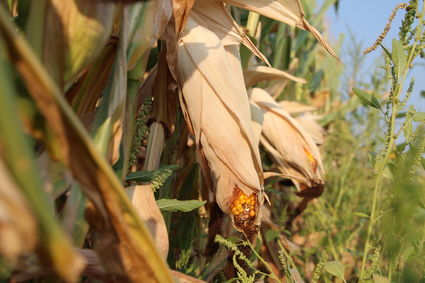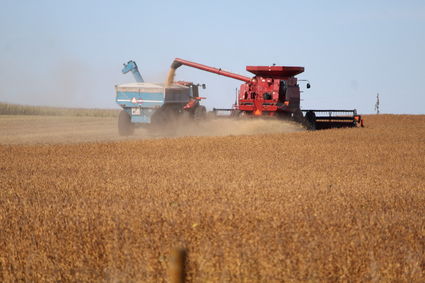Dry enough for ya?
Crops suffering as drought expands in northwest Iowa
September 3, 2020

NICK PEDLEY/SENTINEL-NEWS
Ears have dropped and many corn fields have turned a shade of harvest gold over the past two weeks. According to the U.S. Drought Monitor, Iowa is the driest it's been since 2013.
You don't need a weatherman to tell you which way the wind is blowing, and you don't need one to tell you when it's too dry out.
A quick drive outside city limits will reveal crunchy cornfields and singed soybeans. Precipitation was in short supply this summer during key periods of the growing season, making local farmers and ag experts pessimistic about yield potential as harvest season nears.
"They always say you make beans in August, but we didn't get any rain," said Mason Mentink, an agronomist at MaxYield Cooperative in Everly.
According to the latest data from the U.S. Drought Monitor, 96 percent of Iowa is experiencing conditions ranging from abnormally dry to extreme drought. Roughly 65 percent of O'Brien and Clay counties are in severe drought with the other portions experiencing moderate drought. An 11-county cluster in west central Iowa has the driest conditions right now with portions suffering extreme drought.
The Hawkeye State is the driest it's been since 2013. CFE agronomist Jameson Hennings said the farther south you go in O'Brien County, the worse it gets.
"The heavier soils are holding their own, but corn has pretty much given up it seems," said Hennings. "Everything seems to be showing that heat stress. We haven't seen a year like this in a long time."
Both Hennings and Mentink expected respectable yields for corn this year, but were less hopeful for soybeans.
"I think the top-end on corn has been shaved, but I think we've lost most of that top-end for this year's bean harvest," Mentink said.
Some small bean fields with lighter soil have been harvested already in Clay County.
"They're usually starting on beans around fair time there, and we're still two weeks ahead of when that would be," Hennings said Monday.
Mentink expected the best soybean yields to be between 50-55 bushels per acre. While he was more optimistic about corn, he said potential hazards are lurking.
"I'm concerned about standability in some fields," he said. "This fall when we have stuff ready to go, I think we've got to be out there and getting after it right away."
Mentink was hopeful for a fast and uneventful harvest. Conditions during planting season were exceptional and many farmers were hoping for a great year; however, the clouds just never gave up the wet stuff when fields needed it most.
"Who would have thought that with the great way things started out this spring compared to previous years, that this is where we'd be," said Mentink. "It's 2020, though, so nothing is really surprising anymore."
• Crop conditions lag; state officials warn of propane shortages
According to the latest crop update report by the Iowa Department of Agriculture and Land Stewardship, topsoil moisture condition rated 41 percent very short, 40 percent short, 19 percent adequate and 0 percent surplus. The state's topsoil moisture condition deteriorated to 81 percent short-to-very short. Subsoil moisture condition rated 37 percent very short, 40 percent short, 23 percent adequate and 0 percent surplus. The state's subsoil moisture condition dropped to over three-quarters short-to-very short.
Corn was 95 percent in the dough stage or beyond, more than two weeks ahead of the previous year and six days ahead of the five-year average. Almost three-quarters of the corn crop is in or beyond dent stage, more than two weeks ahead of the previous year and one week ahead of average. The crop seems to be speeding towards maturity with 11 percent of the crop mature, 18 days ahead of last year and six days ahead of average. Corn condition rated 45 percent good-to-excellent, a drop of 5 percentage points from the previous week and the lowest level since the week ending Oct. 20, 2013.
Soybeans setting pods were over two weeks ahead of last year and four days ahead of average at 96 percent. Soybeans coloring reached 29 percent. That is the highest percentage of soybeans coloring by Aug. 30 since 2012. Soybean condition fell again this week with the crop now rated 50 percent good-to-excellent, the lowest level so far this season.
Alfalfa hay third cutting was 86 percent complete, almost three weeks ahead of last year and 11 days ahead of the five-year average. Pasture condition fell 7 percentage points this week to just 16 percent good-to-excellent. Many cattlemen have had to begin supplemental feeding of hay due to deteriorating pasture conditions, according to the report.
If drought and increasingly poor crop quality wasn't bad enough, state officials are also urging farmers to prepare for potential propane shortages this fall.
Iowa Secretary of Agriculture Mike Naig this week urged farmers and agribusinesses to start evaluating how much propane they'll need to meet grain drying and home and livestock heating demands this fall and winter. The derecho that swept through Iowa on Aug. 10 created many unknowns for this year's harvest, which could create increased propane demands this fall.
"After an ideal planting season and a warm, dry summer, we anticipated normal crop dry-down this fall, but the drought and derecho had significant impacts on our corn fields," Naig said in a news release. "I encourage farmers to take a look at their grain drying and home and livestock heating needs, and formulate a plan with their propane suppliers to make sure their needs are covered and their tanks are full."
The derecho's sustained, high winds damaged an estimated 3.57 million acres of corn in 36 counties, just a few weeks before the harvest. While the degree of damage varies by field, millions of acres of corn stalks were snapped, flattened or tangled. This will reduce the amount of airflow around the crop, and Naig's office said farmers should anticipate harvested corn will have higher-than-normal moisture levels.
Naig also urged them to start engaging in planning conversations with their local propane suppliers, take advantage of early buying and booking programs, and top off their tanks now before harvest begin.





